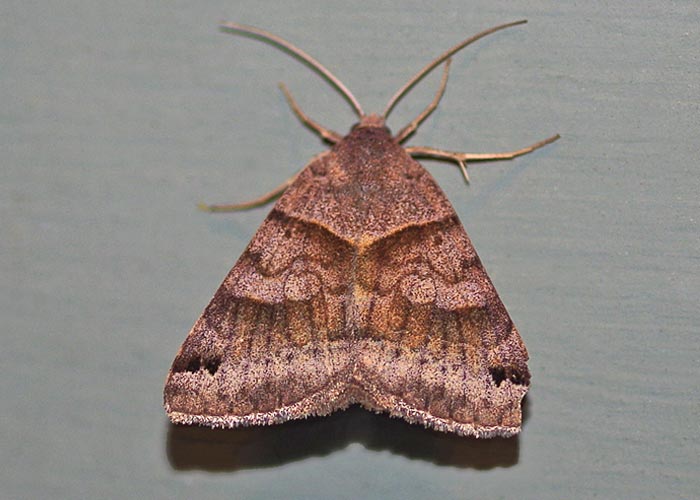Salutations, BugFans,
The BugLady wishes that the Moth Namers (usually a pretty creative lot) had come up with a nicer name than “Forage looper” or the slightly better “Grass looper” for this pretty moth that appeared on her porch one night at the start of August. Maybe with the word “tawny” or “caramel” in it (there’s variation within the species, of course; the males are generally grayer and the females, with their 1 ½” wingspreads, larger.

Grass Looper Moth
For the record, the BugLady is pretty sure that this is a Forage looper (Caenurgina erechtea) instead of the very similar Clover Looper (C. crassiuscula). Both occur across North America and southern Canada (not so much in the Great Plains), right up to the southern edge of the boreal forest, but the Clover looper is said to replace the larger and more common Grass looper in more northerly parts of Canada. If the moths are challenging to differentiate, their caterpillars can be worse. The GL likes moist, well-vegetated, open fields, edges, and disturbed vegetation.
There are probably two broods in Wisconsin—a small, spring flight from pupae that were caterpillars the previous summer and that survived the challenges of winter (and spring), and a larger mid-summer flight that produces those caterpillars that overwinter. GL moths may be seen by day or night through September. Larvae tend to be more strongly nocturnal than their parents, and they are fairly specialized feeders, enjoying herbaceous (not woody) members of the pea/legume family, especially the clovers. Grasses and ragweed have also been listed as food plants.
The GL has been a subject in a number of research projects that have searched for a correlation between a moth’s ability to hear and its anti-predator behavior. Not surprisingly, it seems that although auditory acuity varies, moths that have “ears” (and GLs do) are likely to fly more frequently at night and to spend more time in flight than “earless” moths are. Since finding a mate may require taking to the air, flight is an important exercise. Moths with poorer hearing behave more like earless moths, hunkering down in the vegetation.
Researchers Hannah te Hofstede, et al., speculate that that this auditory advantage in the high-stakes game of finding a mate might result in the selection for/development of enhanced sensory equipment, but that moths apparently have maxed out their hearing development, so their energy goes into behavioral responses. Other scientists have noted that moths that are exposed to ultrasound cut their flying time dramatically. It has also been suggested that moths respond differently to the sound of a bat hunting far away vs. a bat close-up (“Far-bat” triggers a leisurely retreat, while “Near-bat” inspires erratic flight or a quick landing).
One branch of the pest-control field, Electronic Pest Control, involves broadcasting short wavelength, high frequency sound waves both as a repellent and to interrupt breeding activity (so far, there have been inconsistent results over both the range of species and the range of devices. Back to the drawing board). The Pros: no chemicals leaching into the landscape. The Cons: according to some sources, electronic pest control devices are not subject to the same kinds of federal scrutiny as chemical pesticides are. The BugLady suspects that the use of ultrasound would result in significant collateral damage to “harmless,” eared insects and maybe to bats, which give us a pretty good assist in insect control.
GLs belong to the Family Erebidae, a large family that was carved out of the Owlet family Noctuidae and that includes the underwing, tiger, tussock, lichen, snout, and zale moths, and more. Erebids come in all sizes from micromoths to the Black Witch, with her five-inch wingspread, and they range in color from the well-camouflaged to the very-showy. According to BugGuide website, “Erebidae” comes from the Greek erebus, which means from the darkness.
The BugLady’s favorite GL research moment came from this caption at the Roger Tory Peterson Institute of Natural History. “This appears to be a Forage Looper moth (Caenurgina erechtea), another one of our common enough neighbors that we would never see if we were not trying to find them or crawling through the grass. Sometimes rolling around on the ground can be very educational.”
The Bug Lady